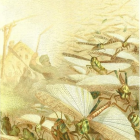In the summer of 1882, villagers in the Bombay Presidency witnessed a ghastly sight: a swarm of locusts descended upon their crops and started devouring any vegetation in site. The villagers remained indoors waiting for the calamity to end. Soon the Mamlatdar—a local revenue officer appointed by the British administration—arrived with policemen. He had orders from the district collector to convince villagers to participate in efforts to mitigate the calamity. The villagers refused to cooperate, as the locust swarm was interpreted by them as an omen of god and any interference could further aggravate god’s anger. The mamlatdar thus proclaimed that if the villagers declined to help in locust annihilation work, they would lose any remission that the government would have provided if their crops were damaged by locusts. Nevertheless, despite the best efforts of the state machinery, the exercise of locust extermination remained largely heterogenous with only lower castes like Kaliparaj and Bhils actively participating. The reason for this lay much in their position of vulnerability brought forth by colonial agrarian expansion into wastelands.

Bombay Locust (Acridium succinctum) as ordinarily found when it does not swarm and change colour.
Bombay Locust (Acridium succinctum) as ordinarily found when it does not swarm and change colour.
Unknown illustrator, 1909.
Accessed via Flickr on 23 March 2021. Click here to view source.
Originally published in H. Haxwell-Lefroy and F. M. Howlett, Indian Insect Life: A Manual of the Insect of the Plains (Tropical India) (Calcutta and Simla: Thacker, Spink & Co., 1909).
 This work is licensed under a Creative Commons Public Domain Mark 1.0 License.
This work is licensed under a Creative Commons Public Domain Mark 1.0 License.
During the nineteenth and early twentieth centuries, locust outbreaks came to acquire enormous significance in the colonial discourse. Among major locust invasions in nineteenth-century India were those of 1869 in Rajputana and Punjab, 1878 in Madras Presidency, and of 1882–83 in the Deccan. Locusts were insects that fed on crops and presented a major threat to agricultural production. By the mid-nineteenth century, agrarian revenue surplus formed a major chunk of cash flow to Britain that made it pertinent to ensure not only a fruitful harvest but also maximal production. Thus, the expansion of area under cultivation was followed by systematic efforts during the late nineteenth century to enact measures like locust control to ensure maximum productivity.
In its mission to expand the cultivable area, the colonial state began acquiring wastelands—some of which were part of village commons. They began “taming” these lands to make them suitable for agriculture. Thus, commenced a process of “colonizing” the landscape that was to shape the lives of marginalized communities to a great extent. The wastelands were anything but “waste” and often provided means of sustenance to the lower caste and “tribal” populations. In times of dearth, wastelands served the nutritional needs of marginalized communities, being a habitat for root tubers, hogs, and partridges. With the wiping out of wastelands these species disappeared, rendering the dependent communities helpless.
In western India, the Kaliparaj people constituted the lowest rung of caste hierarchy and mostly served as “hereditary servants” to upper caste landed gentry. Described in colonial records as “dark” races, they were categorized as aboriginal tribes. Similar to the serfdom system in medieval Europe, the chains of servitude tied them to their upper caste masters in a way that their livelihood depended entirely on their master’s will. They were often dependent upon them for food supplies and perpetually lived in a state of scarcity, with only coarse grain available to them for their survival. Most of them had never even tasted rice. Thus, wastelands provided an alternative source of sustenance that was whisked away from them as the colonial authorities made inroads to the wasteland area in Bombay Presidency.

Illustration depicting an attack by a swarm of migratory locusts and a man in the background trying to drive them off.
Illustration depicting an attack by a swarm of migratory locusts and a man in the background trying to drive them off.
Unknown illustrator, n.d.
Accessed via Flickr on 24 March 2021. Click here to view source.
Originally published in Wood, John George, and Joseph B. Holder, Our Living World; An Artistic Edition of the Rev. J. G. Wood’s Natural History of Animate Creation, vol. 3 (New York: Selmar Hess, 1885).
 This work is licensed under a Creative Commons Public Domain Mark 1.0 License.
This work is licensed under a Creative Commons Public Domain Mark 1.0 License.
Similar was the condition of Bhils in Khandesh—also a part of the colonial category of “dark races.” Historically, they were forest inhabitants who had served as village watchmen and forest guides to caravans helping them navigate through forested tracts. Colonial records also accused them of banditry. For this marginal community, mobility represented a fulcrum of their social life, and migration into the forests in times of famine or distress constituted their historical feature. With the expansion of agrarian cultivation and the emergence of forest acts, the forest tracts came under direct imperial control, resulting in the Bhils losing their critical refuge in forests.
The colonial state, determined to fight the problem of locusts, saw the vulnerable position of these lower castes as an opportunity to kill two birds with one stone. The first was to recruit them in the essential task of locust extermination that upper castes were hesitant to participate in, and the other was to induct the “savage” and “lawless” population into mainstream society. Thus, ironically, colonial administrators employed the Bhils—whom they described in reports as “pests”—to kill the pests.
In 1883, these marginal communities resisted the shackles of servitude imposed by their dominant caste masters to participate in the destruction of locust swarms. They also put aside religious notions against locust killing in desperation for ensuring the subsistence that had otherwise hindered upper-caste participation. They were employed to collect and destroy the locust eggs. Initially, a daily wage was offered but unsatisfactory efforts led to a more result-oriented mode of payment whereby they were offered 3 annas per ser. However, despite the best efforts of the British state towards locust annihilation, results were hardly fruitful. The majority of locusts were exterminated by monsoon deluges and birds, further dwindling the employment prospects of marginalized communities and pushing them back to the fringes.
While, the encroachment to wastelands certainly impacted the livelihood of the marginalized communities, on the other hand, it also paved the way for increased locust outbreaks. Recent studies have highlighted how agricultural expansion aggravated locust occurrences in places like Bukhara. However, to what extent the British agrarian policies of expansion led to an upsurge in locust plagues would be an aspect worth probing and is a subject of a future paper.
How to cite
Das, Pallavi, and Vineet K. Giri. “Locust Infestations and Marginalized Communities in Colonial Western India in the Nineteenth Century.” Environment & Society Portal, Arcadia (Spring 2021), no. 12. Rachel Carson Center for Environment and Society. doi:10.5282/rcc/9262.
ISSN 2199-3408
Environment & Society Portal, Arcadia
 This work is licensed under a Creative Commons Attribution 4.0 International License.
This work is licensed under a Creative Commons Attribution 4.0 International License.
2021 Pallavi Das and Vineet K. Giri
This refers only to the text and does not include any image rights.
Please click on an image to view its individual rights status.
- Breman, Jan. “The Class Struggle Launched and Suppressed.” In Capitalism, Inequality and Labour in India, 94–124. Cambridge: Cambridge University Press, 2019.
- Dagyeli, Jeanine Elif. “The Fight Against Heaven-Sent Insects: Dealing with Locust Plagues in the Emirate of Bukhara.” Environment and History 26 (2020): 79–104.
- Damodaran, Vinita. “The East India Company, Famine and Ecological Conditions in Eighteenth-Century Bengal”. In The East India Company And The Natural World, edited by Vinita Damodaran, Anna Winterbottom, and Alan Lester, 80–98. London: Palgrave Macmillan, 2015.
- Kaushik, Shubhneet. “A Small History of Bedbugs in India.” Indian Journal of History of Science 53, no. 1 (2018): 65–75.
- Kothiyal, Tanuja. Nomadic Narratives: A History of Mobility and Identity in the Great Indian Desert. Cambridge: Cambridge University Press, 2016.
- Roy, Rohan Deb. “White Ants, Empire and Entomo-Politics in South Asia,” Historical Journal 63, no. 2 (2020): 411–436.
- Whitehead, Judith. “John Locke, Accumulation by Dispossession and the Governance of Colonial India.” Journal of Contemporary Asia 42, no.1 (2012): 1–21.









